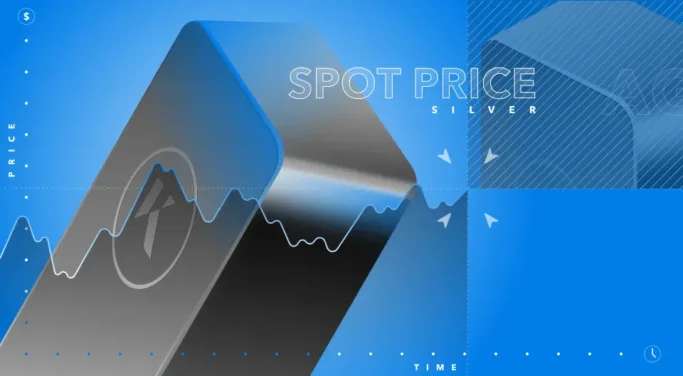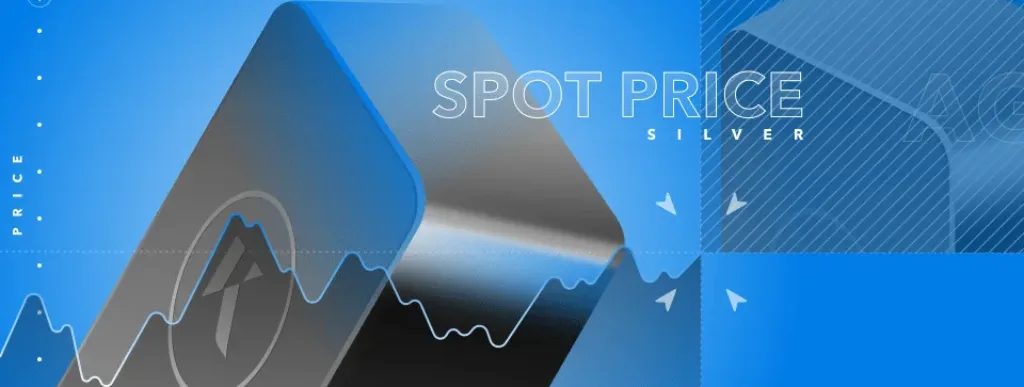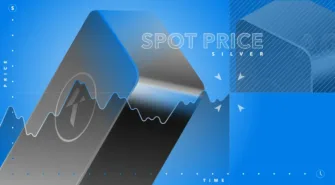The silver spot price is the live benchmark price at which you buy or sell an ounce of physical silver on a particular date and time.
As this is a dynamic market with many factors influencing it, the spot price of silver constantly fluctuates.
As well as the spot silver price, there is also a highly liquid silver futures market. The futures market price provides traders and investors with an insight into the spot price of silver over the longer term.
What is the spot price?
The gold and silver spot prices are the prices at which you can buy each metal. So, for example, the spot price of silver today shows you what silver sells for right now on international markets.
The spot prices of silver and gold vary according to supply and demand although the gold spot price is generally more stable. That’s partly down to the gold market being larger and the role of gold as a reserve asset and investment status during economic downturns.
Despite the lower volumes of silver traded, many traders and investors keep a constant watch over the silver live spot price. One main reason for their interest is that silver is cheaper than gold and that movements in the silver price are higher in percentage terms.
The main value of the silver spot price today is to dealers, jewellers, traders, fabricators and other interested parties. The spot price provides them with a reference price to work with.
Demand from manufacturers drives silver prices in part. According to Kinesis’ in-house writer, Alex Boast:
“Silver is used heavily in the enormous technology manufacturing industry. Silver is unique in that it is the most reflective metal, with the highest thermal and electrical conductivity.”
The information on market tickers showing silver’s live price is in dollars per ounce of silver. Sometimes, traders price silver by price per kilo or gram. Given the global appeal of the metal, you can check silver price charts online against many different currencies.
The way to calculate the silver price also depends on the physical form the silver comes in. For example:
- Silver bullion products: Silver bullion and silver bars trade close to the silver spot price. Sometimes, dealers may want a premium to cover manufacturing, distribution and dealer fees.
- Silver coins: Government silver coins that are legal tender can command a premium above the spot price. Examples include the Canadian Silver Maple Leafs or American Silver Eagles.
- Scrap silver: Scrap silver is silver in a form that’s not used for investment. Scrap silver is silver removed from industrial products, jewellery and so on. The cost depends on how expensive it is to refine and the purity of the silver.
- Sterling silver: Sterling silver is 92.5% silver and 7.5% other metals, typically copper. Like scrap silver, the cost is often below the spot price after refining costs and because of the presence of other metals.
Spot silver reflects the price of silver now. Let’s look at the futures market, in particular the COMEX Silver market operated by the Chicago Mercantile Exchange (CME) Group. This is just one indication of where silver prices could be heading.
How are silver futures prices calculated?
There are three different types of silver futures products available on the COMEX:
- Silver futures contracts (minimum contract size of 5,000 troy ounces)
- Micro silver futures (minimum lot size of 1,000 ounces)
- E-mini silver futures (minimum contract size of 2,500 ounces)
On silver and mini silver futures contracts, the seller must deliver the silver purchased in the contract by the buyer when the contract expires. For the e-mini contract, delivery occurs when the buyer settles the contract financially.
Trading on these contracts starts for delivery in the current month and extends as far out as two years into the future. Typically the nearest month to delivery is the most liquid contract. The price that these different months are trading out sets the curve for the silver futures market.
When the current delivery price is more than the future delivery price, traders call this backwardation. This is a sign of a strong market with high demand.
On the other hand, when the future delivery price is higher than the current price, traders call this contango. Many traders consider this a price alert indicative of a weak market.
Silver monthly contracts are traded on the COMEX exchange during office hours. The market is highly liquid with tight spreads between bids (the buy price) and offers (the sell price).
The volume of silver trades buy and sell is much higher than the volume of available silver. Futures contracts often change hands many times before delivery or settlement date.
How is the silver price determined?
As well as the spot and futures price, there is also the London Bullion Market Association (LBMA) Silver Price. The price is the global benchmark price for unallocated silver delivered in London.
To determine the price of silver, the ICE Benchmark Association (IBA) holds an auction at 12 p.m. each day.
Sixteen banks and trading houses registered as direct and indirect take part in this daily auction. The trades placed by these firms during the auction form the basis for the LBMA’s silver price.
The final price of the auction becomes the official Silver Price and the firms settle the auction in US dollars. ICE then publishes the price in international currencies based on the foreign exchange levels at the time.
In summary, there are three main prices for silver. They are:
- The spot price for immediate purchases
- The futures price for the delivery of silver in the upcoming month
- The daily LBMA silver price is the benchmark used for long-term contracts
How does Kinesis’ silver price differ from spot silver?
As well as the silver prices mentioned above, Kinesis has created its own silver-backed digital currency, KAG – the price of which is determined by fully allocated physical bullion.
KAG combines the timeless value of physical silver with a cryptocurrency’s borderless value and efficiency – and none of crypto’s inherent volatility.
Kinesis KAG is available as a silver-backed token, underpinned by the equivalent volume of physical silver (of a minimum fineness of 999). Each KAG is backed by one ounce of fine silver stored in fully insured and audited vaults.
Kinesis’ silver price is based on fully allocated physical silver with 1 KAG the price of 1 ounce of fully allocated silver.
The KAG silver price is calculated via the aggregation of the silver in vaults across the world, giving Kinesis the ability to offer some of the best available prices for physical silver.
By making silver digital, KAG makes this timeless asset relevant to the modern world.
Rupert is a Market Analyst for Kinesis Money, responsible for updating the community with insights and analysis on the gold and silver markets. He brings with him a breadth of experience in writing about energy and commodities having worked as an oil markets reporter and then precious metals reporter during the seven years he worked at Bloomberg News.
As well as market analysis, Rupert writes longer-form thought leadership pieces on topics ranging from carbon markets, the growth of renewable energy and the challenges of avoiding greenwash while investing sustainably.
This publication is for informational purposes only and is not intended to be a solicitation, offering or recommendation of any security, commodity, derivative, investment management service or advisory service and is not commodity trading advice. This publication does not intend to provide investment, tax or legal advice on either a general or specific basis.
Read our Editorial Guidelines here.




